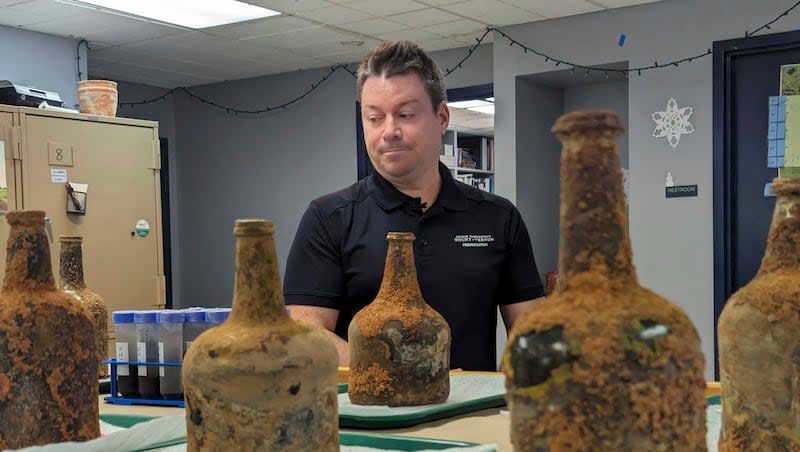Centuries-old cherries discovered at Mount Vernon. How does this year’s crop look?

- Oops!Something went wrong.Please try again later.
Archaeologists discovered dozens of bottles of cherries and berries preserved in storage pits at George Washington’s Mount Vernon home on the banks of the Potomac River.
The discovery of so much perfectly preserved food from more than two-and-half centuries ago is unprecedented, Jason Boroughs, Mount Vernon’s principal archaeologist, told The Associated Press.
“Finding what is essentially fresh fruit, 250 years later, is pretty spectacular,” he said. “All the stars sort of have to align in the right manner for that to happen.”
The bottles were found during a $40 million revitalization project of the mansion expected to be finished in 2026. Archaeologists say the bottles predate 1775 because that’s when an expansion of the house led to the area being covered over with a brick floor.
Whole pieces of fruit, recognizable as cherries, were found in some of the bottles. Testing is underway to confirm what appears to be gooseberries or currants in other bottles, per AP.
Mount Vernon is working with the U.S. Department of Agriculture, which is conducting DNA testing on the fruit. They are also examining more than 50 cherry pits recovered from the bottles to see if any of them can be planted.
Benjamin Gutierrez, a USDA plant geneticist, said the chance that any of the seeds would grow is a long shot. Dry seeds preserve better, and most of the samples found at Mount Vernon were waterlogged. A couple of pits tested initially were not viable as seeds, the AP reported.
A new crop
While the USDA experiments with George Washington’s centuries-old seeds, the harvest of Northwest-grown sweet cherries has begun. Peak growing season runs from June to August.
“Growers are calling the 2024 Northwest crop a perfectly average crop of excellent quality cherries,” B.J. Thurlby, president of the Northwest Cherry Growers, said in a press release. “We are seeing cherries well spread throughout the tree canopy with fewer large clusters than we saw in 2023. Combined with the warm weather, volumes are ramping up.”
Northwest Cherry Growers includes orchards in Washington, Oregon, Idaho, Utah and Montana. The 2,500 growers in those states make up over 70% of the fresh cherries found in stores from mid-June through early September.
Cherry growers in the West are hoping for a return to normal this year after extreme weather and poor market conditions led to lackluster crops every year since the COVID-19 pandemic, per The Spokesman-Review.
The organization predicts between 17 million and 20 million boxes, each weighing 20 pounds, will be harvested this year, a 12% increase over last year.
In Utah, the USDA forecasts 40 million pounds of tart cherry production, up 22% from the 32.7 million pounds produced last year. Tart cherry production nationally is expected to hit 222 million pounds, a 34% increase over 2023.
Last year, a record cold and wet spring put California’s cherry harvest behind by several weeks, Thurlby told The Spokesman-Review. California also recorded a near-record yield, meaning there were a lot of California cherries still on the market when Northwest growers hit their typical harvest peak in early July.
“Cherries don’t store the way apples and pears do, to be then sold weeks and months later,” said Jon DeVaney, president of the Washington State Tree Fruit Association. “So when we had the cherry season compressed significantly, it led to some very bad pricing for growers.”
Cherry on top
Cherries might have to be sold quickly before they go bad, but apparently putting them in jars can preserve them for centuries.
Gutierrez told the AP that the bottles discovered at Mount Vernon are a remarkable find. In addition to DNA testing, he said chemical testing may be able to show if particular spices were used to preserve the fruits.
The cherries were most likely bottled to be eaten simply as cherries, Boroughs said.
The quality of the preservation reflects a high caliber of work, according to AP. Slaves ran the plantation’s kitchen. The kitchen was overseen by an enslaved woman named Doll, who came to Mount Vernon in 1758 with Martha Washington, according to the estate.
“The enslaved folks who were taking care of the trees, picking the fruit, working in the kitchen, those would have been the folks that probably would have overseen and done this process,” Boroughs said. “It’s a highly skilled process. Otherwise they just wouldn’t have survived this way.”

